[This review has already been read by the Looking Closer Specialists, whose helpful responses persuaded me to see the movie a second time before publishing it. Thanks, Specialists! Read about how you can join the club that gets first-looks and access to a private Looking Closer Facebook group here.]
•
I am looking at the back of a man who stands on a sandy precipice beside his souped up sports car, and I have just enough time to think three things:
1) Wow, the colors of this post-apocalyptic desert wasteland are so saturated that they make Luke Skywalker’s homeland look positively grayscaled by comparison!
2) Is this guy just scanning the horizon, out beyond the dunes? Or he is preparing to urinate over the edge? And then,
3) I wonder how long this goes before we hit the first chase scene and we see Max —
BOOM!
We’re off! He’s jumping in his car! And the first mad, mad, mad chase scene of Mad Max: Fury Road is underway!
And if you’re not excited about that then you’d better leave now, because this movie blazes and rages and thinks of rapid-fire, high-tension exchanges between key characters as the equivalent of a quiet interlude or “downtime.” Cars! Trucks! Car-trucks! Truck-cars! Truck-car-tanks! Cars that look like the porcupine cars from Peter Weir’s The Cars That Ate Paris. Give these guys a few weeks, and they’ll be riding All-Terrain Armored Transports like in The Empire Strikes Back, but when they do, the AT-ATs won’t be marching—they’ll be galloping and spewing fire!
Insert your heavy-metal pun here, and do it fast, because in a few minutes it won’t be a joke — it’ll be a reality. These guys bring their own soundtrack: a freak tethered to the top of a truck and flinging mad guitar solos as fiercely as possible as if trying to cause sound waves that will outrun this rubber-burning cavalry. He looks like he was drawn by a teenaged Guillermo del Toro after his first Slayer concert,
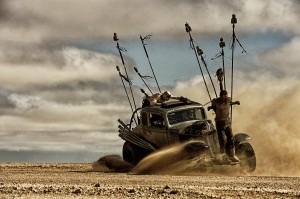
This is just like this year’s NBA finals: There are no rules, anything goes, fouls aren’t called by the refs, and things that aren’t fouls are penalized.
George Miller may have taken 30 years off from what he does best (no disrespect to Babe or Babe: Pig in the City, both of which I loved for wildly different reasons) — but he gets back behind the wheel of his monster-truck imagination as if he’s done little more than dream up how to do that Mad Max thing bigger and better.
Yes, here we are, back to one of the big screen’s many futures. And, as Doc Brown said in Back to the Future, “Where we’re going, we don’t need roads.”
This is the future where the world’s gone to hell, and those who survived are tribes of professional sports fans who cope with the apocalypse by carrying on with what they did before — painting their faces, warring in tribes, and serving corrupt franchise owners. And, just like commercial breaks in televised pro sports, every few minutes there’s a whole lot of fuss about whose truck is the toughest and whose car performs illegal feats of speed and strength.
I remember loving The Road Warrior for its unapologetically absurd marathon of off-road racing, its competitions for craziest post-apoc makeover, its affirmation of cinema as a medium that celebrates motion and momentum. Then came the third film in the series, which followed more hero-myth conventions, taking too many notes from Indiana Jones and the Temple of Doom, and my interested fizzled considerably; I didn’t want to have to take this stuff seriously, and so the action jarred incongruously with the attempt at meaningfulness. (I never seen the first film in the series — Mad Max — and, considering how I’ve never felt like I missed anything crucial, I wonder if it’s necessary at all)
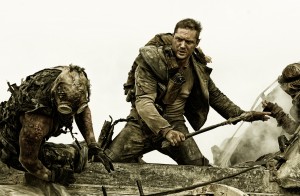
Good news: Mad Max is back, and he’s reluctant to take on any post-apoc-messiah role this time (even if he does get strapped to a cross within the first ten minutes). He’s all business this time around.
Not so good news: When when we last saw him, he was played by the 1980s icon of charismasculinity Mel Gibson. Now he’s played by Tom Cro-Magnon-Man Hardy who, having rid himself of the Bane mask that muffled his words in The Dark Knight Rises, has very little — almost nothing — to say for the entirety of this movie, perhaps for fear of having his sentences cut short by the high-speed cutting, splicing, and dicing of this film’s frantic pace. Max rarely speaks complete thoughts aloud (unless he’s giving us some voice-over). He doesn’t have time. He’s too busy suffering whiplash, concussions, dehydration, imprisonment, torture, and a punishing jailbreak (and that’s just the first five minutes of the movie). For the most part, he’s just Mumble Max — not mad, just sullen. For the rest of the movie, he looks for all the world like a man who would do anything to get into a Locke sequel instead of a Mad Max sequel, because at least in Locke he had backstory, dialogue, interesting decisions to make, and, well, roads.
In the wasted kingdom where Max is locked up, the poor, the bungled, the botched, and the dehydrated citizens look like they’re as desperate for a chance to speak in complete sentences as they are for a sip of the water that their tyrannical overlord — sprays out so insufficiently, like a Californian watering his lawn under the close watch of drought-burdened neighbors. This is the driest movie ever made about the rationing of liquids: the scarcity of water (“Aqua Cola,” they call it); the ruination of the globe over oil; the sacredness of “mothers’ milk”; and the portability of blood in “bags” (that is, human captives). I kept imagining Base Commander Jack D. Ripper from Dr. Strangelove sitting beside me in the theater and nodding his approval of the film’s preoccupation with “precious bodily fluids.”
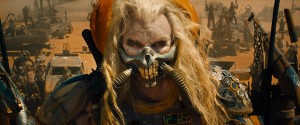
The aforementioned tyrant — Immortan Joe (no, that’s not a spelling error), played by Mad Max veteran cast member Hugh Keays-Byrne — has taken lessons from several familiar villains: he’s like Darth Vader, strapping himself into a bellows-mask that amplifies his breathing; he’s like Batman’s Bane, trying to make himself intelligible through the mask as if to beat Hardy at his own game; and he’s like Baron Harkonnen of David Lynch’s Dune, being so misshapen, corpulent, and generously pimpled that he needs custom-fitted body armor. (This doesn’t stop him personally putting pedals to the metal with his own tumescent foot, leading the charge in pursuit of those who would escape the range of his voice.) Why be just a villain when you can be all the villains?
Joe has built himself a slavish, brainwashed army of “Warboys”: white-fleshed boys who compete for his favor by their enthusiastic willingness to risk life and limb for him, hoping to be welcomed into some holy company in Valhalla. They’re so much fantastic fun to watch that it’s disappointing when you realize that this movie is set up to watch them outwitted and outfought. What I really want to see is this entourage running down the cast of, well, Entourage. (Hey, we wanted Alien vs. Predator and we got it, so, why not this?)
And so the chase is on: This time, the evil heavy metal band of water-reservoir dogs are barking at the heels of a “War Rig”: a tanker that was supposed to go fill up with fuel at Gastown, but which has been commandeered by a Joan of Arc look-alike (but not a Joan of Arc think-alike) called Furiosa (Charlize Theron, who gets impressively furious-a and furious-a as the film goes on).
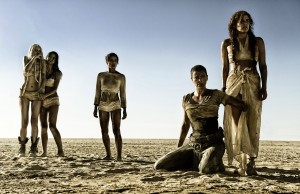
She’s not interested in fuel; she’s more interested in rescuing Immortan Joe’s harem of young Maxim-covergirls. In 2015, you need to make your audiences care with a social-justice subplot, so Fury Road casts an ethnically diverse lineup straight out of Australia’s Next Top Model and goes just far enough to make the words “human trafficking” — or at least “human traffic” — flash through your head so that you can feel righteous about loving this hyperviolent free-for-all. One of them is very pregnant with a baby, or maybe a tumor, or — most useful of all — a spare tire. Most moviegoers would presume that, since this isn’t a rom-com, it would be preposterous to have her go into labor mid-chase — but what this movie presupposes is “What if it isn’t?”
This is where the rest of the movie blurs in my memory — it becomes one truly spectacular chase-scene/demolition-derby after another, a circus of acrobatic stunts that would make Indiana Jones say, “I am definitely too old for this shtick.”
There are moments that almost qualify as interludes or pauses, when Joan of Arc puts it in park, and we get to hear a few lines of dialogue — sparsely indulged (for the sake of saving saliva, I assume) — about whether Max and Furiosa should trust each other; where Furiosa thinks she’s going; whether or not “Hope is a mistake”; and what to do about their stowaway warboy (Nicholas Hoult, who, from X-Men to Warm Bodies to this, seems determined to give better and better performances in increasingly complicated makeup jobs). They slow down to make their way through a oil-soaked bog where natives crawl around on stilts — this movie’s answer to The Dark Crystal‘s landstriders. They also find a biker gang of elderly women—this movie’s answer to The Dark Crystal‘s Aughra. Resembling Star Wars Tusken Raiders, these sandpeople are surprisingly precise with their shotguns
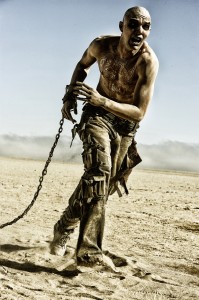
Once we reach the Mad Matriarchs, we’ve reached Peak Meaning in Fury Road. Since it wouldn’t be any fun for them to just go on fleeing over the horizon, the movie decides to close the gap between aggressors and persecuted, and proceeds to a conclusion that wants to be seen as a hopeful triumph but leaves me thinking, “Um… wait five minutes, and I think things are going to take another nasty turn.”
Sure enough, it seems there are two sequels in the works — the first of which will be called The Wasteland. So I intend to spend this summer studying up on T. S. Eliot so I’ll be ready for it.
To spend much time wringing meaning out of Mad Miller: Beyond Happy Feet would be like trying to write theological poems based on the Fast and Furious series. I might read and even enjoy such poems, but they would say more about the creativity of the reviewer than the profundity of their subject. I’ve read reviews that try to make Fury Road into a philosophical treatise, and they sound like the critics’ vain attempts to justify their love of this franchise by trying to make it sound important. Fact is, there’s nothing wrong with loving spectacular big-screen choreography, stunts, motion, and momentum. Why can’t we just celebrate that? Sure, this Mad Max movie is a product of its times, and I applaud its capital-V “Values.” But working hard to make people take this story seriously robs the movie of its fun.
Let’s not take the MAD out of Max, or there just isn’t any point.
Actually, let’s stop talking about Max. This movie belongs to Charlize Theron, and if the series were to follow her from now on, I would follow the series with more enthusiasm.
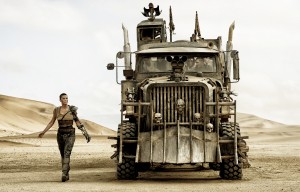
In a way, I’m grateful for this movie: It packs enough implausibly spectacular high jinks into one movie to make up for a pile of tepid summer “blockbusters.” And it does so with imagination, wit, enough real-world stunts to create a powerful sense of high stakes, and performances that register with real emotion in the midst of absurdity. What’s more — it demands an enormous screen, so it’s a ringing endorsement of the theatrical experience.
It’s explosive fun. It’s even more fun the second time. And I think it’ll be justly celebrated as one of the all-time great achievements in action moviemaking.
But now, having watched it, I’m ready to move on to Oscar season to reactivate things like the Intellect and the Soul.
What? It’s still June?
Gonna be a long summer.